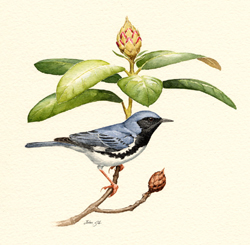Breeding Bird Atlases (BBA)
Find a Bird - BBA1
Breeding Bird Atlas 1 Species Accounts
Black-throated Blue Warbler
Dendroica caerulescens
Egg Dates
May 23 to June 10
Number of Broods
one; occasionally two

This is a warbler that is generally associated with the northern mixed forest, and in fact it is found breeding in or near deep woods. The preferred sites seem to be in openings such as forest clearings, stream or wood borders, or hillsides of secondary-growth maples and beeches. In more southern sections, the birds are especially attracted to wooded regions with a heavy undergrowth of Mountain Laurel, while in more northern areas an understory of American Yew seems to be most desirable.
The nesting distribution of the Black-throated Blue Warbler in Massachusetts is determined by the occurrence of these special types of forest. They are found from Berkshire County east to Worcester County but are most abundant in the more western regions. Some breeding occurs in northwestern Middlesex County, but the species is totally absent as a nester from all eastern parts of the state.
The return of the resident birds in the spring occurs mainly from the end of April through the first week of May, with stragglers continuing to arrive later in the month. Because much of the breeding range lies to the north of Massachusetts, many migrants continue to pass through the state during May, at which time they may be found in regions where they do not nest. Breeding males are very territorial, and, although they may chase and fight one another, much of their behavior at this time consists of long song bouts. Males have at least two main song types with many variations. Three representations are an ascending zee-o, zee-o, zee-o, zee; a more rapid hur, hur, hur, hur, weeee; and a husky dzeurr, dzeurr, dzee. Males with atypical songs are regularly encountered. The common call notes of both sexes include a sharp chuck, similar to that of the Dark-eyed Junco, and a high, thin seet. In addition, the males have a call consisting of a series of bzz notes, and the young have a three-syllable, trilling, begging call.
Nests, constructed by the female, are generally placed from 1 to 4 feet from the ground in a low tree or shrub, most often Mountain Laurel, Eastern Hemlock, spruce, or yew. They are composed of twigs, bark, and leaves, with a lining of rootlets and hair. Two nests in Pelham were situated as follows: 1, 9 inches up on two dead branches hidden in a mass of ferns; 1, 15 inches up on two dead branches in the center of a nearly dead alder. The first was covered with strips of birch bark and lined with pine needles, and the second was constructed almost entirely of pieces of bark of the Yellow Birch (Nice 1926, 1930). A nest in Rowe was located 3 feet up in a hemlock sapling growing in a thick clump (EHF).
The usual clutch is four eggs, but three and rarely five are produced on occasion. Five clutches from Worcester County each contained four eggs (DKW). Incubation, by the female, lasts about 12 days, and the young remain in the nest for 10 days, during which time they are tended by both parents. In Massachusetts, nestlings have been reported from June 19 to July 18 (EHF; Nice 1926, 1930). A brood of four young in Pelham was estimated to be 3 days old on June 24. The first youngster fledged on June 30 (Nice 1930). A single bird fledged from another nest on July 18 (Nice 1926). The Rowe nest contained four young on June 19, and these had fledged on June 21 (EHF), indicating that hatching probably occurred about June 12. Fledglings are fed for several weeks as they gradually attain independence. Adults feeding fledged young have been observed in the state from June 21 to August 20 (EHF; Nice 1926, 1930). The late date was for a female with two large young in Brookfield. The July egg dates and August fledgling dates indicate that the species is at least capable of successful, late renesting attempts and may occasionally rear two broods.
By late July and early August, sometimes later, the young birds have acquired their winter plumage and the adults are undergoing a complete molt. While some individuals join the characteristic mixed-species flocks of Black-capped Chickadees, warblers, and other species that occur in this season, many of the males seem to remain on or near their breeding territories. Black-throated Blue Warblers have a definite postmolting song period.
As August comes to an end, the resident birds begin to move out on their southward flight. Throughout September and into mid-October, they are followed by migrants from farther north. A few stragglers occur after this time. The wintering grounds center mainly in the West Indies.
Map Legend and Data Summary
Atlas 1 data collected from 1975-1979


Note: fairly common in deciduous woodlands of hill country where Mountain Laurel predominates in the understory
W. Roger Meservey



